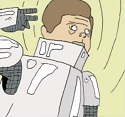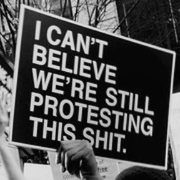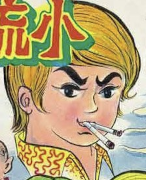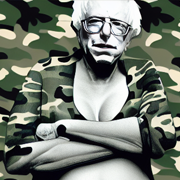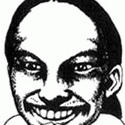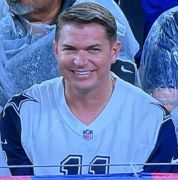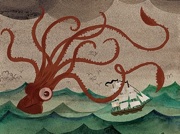- The Atomic Man-Boy
- Jul 23, 2007
-
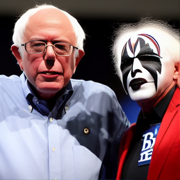
|
Gonna sum up my other favorite chapter:
quote:
Over at Harken Energy—George W. Bush’s next corporate home [...] Bush-connected enterprises were just not the kinds of businesses with which the rest of us are familiar. There always seemed to be something more going on: that overlay of peculiar money-moving, a general lack of profitability, the participation of foreign interests, and a hint of black intelligence operations.
In September 1986, as oil prices continued to collapse and W.’s previous financial savior, the Cincinnati-based Spectrum 7 Energy, was itself failing, along came the Dallas-based Harken, a comparatively little-known independent oil and gas company, riding to the rescue. Harken snapped up Spectrum, put W. on its board, and gave him a handsome compensation package. In return, W. was allowed to go about his business—which at the time meant playing a crucial role in his father’s presidential campaign. But the Harken assist didn’t just benefit Poppy’s political fortunes. Profits from W.’s subsequent sale of his Harken stock would jack up his own political career. The Harken deal ultimately made it possible for him to become part owner and highly visible “managing director” of the Texas Rangers baseball team—a position that would enhance his modest résumé as a candidate for governor a few years later. Thus, the largess of the figures behind Harken played a key role in George W. Bush’s quick march to the presidency.
Virtually everyone who has looked at Harken over the years agrees that it is some strange kind of corporate beast, like a newly discovered species of manatee. The company’s books have never made any sense to outsiders— which might have had something to do with the fact that the only people who seemed to make any money were the insiders. In 1991 Time proclaimed Harken “one of the most mysterious and eccentric outfits ever to drill for oil.
The Harken story reads at times like the stuff of an airport bookstore thriller. One finds figures associated with BCCI, gold caches, and an alphabet soup of secret societies appearing at critical junctures to bail out Harken, traveling to the White House to meet with President George H. W. Bush, then flying off to make deals with the likes of Saddam Hussein or the Chinese in the wake of the Tiananmen Massacre. In Harken we find the future president of the United States deeply involved in an enterprise whose every aspect raises questions about control of power in our country, because it draws our attention to complex and little-understood international alliances that bring America’s leaders, past and future, together with individuals and forces of dubious integrity and ambitions that appear far removed from the public interest.
...
For the first decade of its existence, Harken was a fairly conventional, and mostly profitable, oil exploration firm.3 But in 1983, things began to change. Having been in business for nearly a decade, and now suffering from the collapse of oil prices, founder Phil Kendrick traveled to Asia to consider potential buyers for his Australian subsidiary. One Singapore-based broker happened to bring up a name. “He told me about a guy named Quasha—said he was the man behind Marcos,” Kendrick recalled. “He said he was the one who put him in power.” That may have been something of an exaggeration, but William Quasha was a man to know in the Philippines. An American citizen who had served there during World War II and stayed on to become a powerful lawyer in that country, he was head of the local expatriate group Republicans Abroad, and so well connected that he even played host to a Democrat, President Bill Clinton, when he came through the isles.
William Quasha’s ace in the hole was his relationship with the long-ruling president and strongman Ferdinand Marcos. And Marcos, accused of stealing billions of dollars from the public treasury of the poor country during his twenty-year reign, needed friends with connections abroad. Recalled Kendrick: “The word was, Marcos was trying to get money out of [the] Philippines—he had a lot of money—and place it in legitimate businesses.”
In a curious coincidence, not long after Kendrick first heard the Quasha name, one of Harken’s investment bankers in New York mentioned a client looking to take a major position in an oil company, a New York lawyer named Quasha. He turned out to be William Quasha’s son, Alan.
[...]
Quasha assured him, Kendrick said, that he was going to make Kendrick’s stock options valuable.
According to Kendrick, he did exactly the opposite. “I finally figured out what his game plan was,” Kendrick said. Kendrick alleges that this initially consisted of a press release that portrayed the company as a giant mess that needed to be fixed. “The stock just crashed; it went down to nothing—below a dollar.” Then, the new management announced a rights offering, which allowed people like Quasha to buy still more stock, at a heavily discounted price. This, of course, destroyed Phil Kendrick’s stock options while giving the newcomers even more control. Then the company instituted a one-for-ten reverse split, which brought the stock price up to a no-longer-embarrassing level. Meanwhile, management sold off the Australian subsidiary that Kendrick had been told he could run, and, according to Kendrick, pushed him out. The funding for all this was baffling.
[...]
Why did the Quasha family find this particular company so interesting? Kendrick couldn’t stop thinking about what he had heard about the Quashas and Marcos—and couldn’t help wondering whether the money going into Harken wasn’t really Marcos’s money—or, put another way, the money of the people of the Philippines. I had hoped to get some insight, at least a limited one, from Alan Quasha, but he has repeatedly ignored requests for an interview.
With Kendrick out of the way, Harken began metamorphosing in strange and wondrous ways. As mysterious as the workings of the company was its allure for powerful figures and institutions—almost all of whom piled into the company after George W. Bush came on board in 1986.
One of the oddest investors in Harken was the billionaire speculator, investor, and philanthropist George Soros, who first became involved shortly after Alan Quasha took over the company by swapping oil company stocks for Harken shares; Soros was a major shareholder in the first years following Quasha’s takeover, at one point holding one third of the stock. That George Soros held a big stake and served as a board member at the time George W. Bush was welcomed into the company that would make his fortune is rife with irony. Soros, a refugee from Communist Hungary, would found a variety of progressive philanthropies in the United States and abroad, whose causes included promoting democratic institutions, campaign finance, and drug policy reform. Eighteen years after George W. Bush joined him in Harken, Soros would become the leading financier of efforts to deny W. a second term as president. More consistent with Harken’s geopolitical texture is Soros’s longtime backing of Central and Eastern European democracy movements during the Soviet era. Though Soros exited Harken years ago, he continues to play tennis with Alan Quasha.
By far the biggest—and ultimately the most improbable—of Harken shareholders was Harvard University. Harvard, currently the second wealthiest private institution in America after the Bill and Melinda Gates Foundation, entered the picture in October 1986, right on the heels of George W. Bush. Through its investing arm, Harvard Management Company, it agreed to buy 1.35 million shares of Harken for two million dollars and invest another twenty million dollars in Harken projects—eventually pumping fifty million dollars into the company and owning 30 percent of its stock. Harken, in fact, was one of the largest investments the university ever made.
Equally mysterious is how and why the financial whizzes at Harvard chose to bankroll the apparent clunker. In 2002, when the Boston Globe asked for an interview on the subject of Harvard and Harken, Michael Eisenson, managing director and CEO of the Harvard Management Company, who sat on the Harken board with George W. Bush, declined.13 The university’s motto—Veritas—apparently does not apply to its financial dealings.
In 2002, the Boston Globe, seeking to understand the local school’s involvement with Harken, spoke with Robert G. Stone Jr., the longtime chairman of the seven-member Harvard Corporation, the university’s highest governing board. Stone sought to distance himself from the matter.
“I never recommended Harken. I didn’t know anything about them,” Stone said in a telephone interview from his New York City office in what appears to be his first interview about the matter. “I don’t tell them what to invest in.” He said that at the time of Harvard’s investment, he knew then-Vice President George H.W. Bush “very, very slightly.”
[...]
Despite Stone’s efforts to distance himself from the Bushes and from Harvard’s entry into Harken, Stone himself turns out to have both oil and CIA connections—or, perhaps it can be said, CIA-oil connections. Most intriguingly, Stone turns out to have been in business with the “former” CIA officer Thomas J. Devine. That’s the same Thomas J. Devine who purportedly retired from the agency in order to help Poppy Bush start up Zapata Offshore.
In 1950, the same year that Dresser Industries relocated to Dallas and the whole Dallas intelligence complex was coming together, Stone started Stonetex Oil Corporation, a Dallas-based oil company. Some years later, Devine became Stonetex’s treasurer. (When I asked Devine about his association with the Stone family, he explained that the same ground rules applied as with the Bushes before he could speak to me: “That makes two families I need to get clearance from.” He apparently never did get that clearance.)
Stone was a board member and sometime chairman of a whole range of companies involved with international shipping, the use of inland barges to move oil, and oil exploration. At one point he controlled one of the world’s largest cargo fleets. And he was intimately associated with a small circle of highly politicized oilmen whose names have appeared in previous chapters.
[...]
As a young man, Robert Stone’s marriage into the Rockefeller clan would result in his joining the board of Freeport Mining, a huge Rockefeller-dominated company with gold, silver, copper, and other mineral-extraction operations throughout the world, including major mines in Indonesia and the Philippines. The partners of Freeport Mining were a powerful bunch with an appreciation for the strategic value of minerals. Among the board members over the years was Prescott Bush’s business partner Robert A. Lovett, who served in various administrations as undersecretary of state, assistant secretary of war, and secretary of defense, and is widely regarded as one of the architects of America’s cold war strategy
Freeport’s largest mine was and is in Indonesia—and Freeport is closely identified with the CIA-backed coup that brought the dictator Suharto to power in 1965. Efforts to topple his predecessor, the nationalist Sukarno, were the province of Alfred C. Ulmer, the Allen Dulles confidant who, as noted in chapter 4, visited Poppy Bush in Texas the week of the JFK assassination. Other Freeport board members have included Henry Kissinger and Admiral Arleigh Burke, chief of naval operations under Ike and JFK. Burke was an ardent advocate in National Security Council meetings for the assassination not just of Fidel Castro but also of others in the Cuban leadership as a “package deal.” JFK, just prior to his death, was taking policy stances on Indonesia inimical to the interests of Freeport.
It is in this context—the control and extraction of precious resources— that we meet Robert G. Stone Jr. and William H. Quasha (Alan’s father), as young men doing their World War II service in the Philippine Islands. The Philippines had been a gem in the American colonial empire since it, like Cuba, came under U.S. control after the Spanish-American War in 1898. The Philippines, even more than Cuba, was rich in resources, including gold, copper, sugar, and other strategic commodities.
And more than a few big names did their apprenticeship in the fertile islands. Before he became president of the United States, Bush family associate and Bonesman William Howard Taft was the civilian governor there. So was Henry L. Stimson, the Bonesman who would serve in five presidential administrations—and would address Poppy’s Andover graduating class.22 The family of future American general Douglas MacArthur was part of this same American cadre “managing” the Philippines. Douglas MacArthur’s father, Lieutenant General Arthur MacArthur Jr., was the military governor.
Two other Americans spent time in the Philippines—both in the company of General Douglas MacArthur: Robert G. Stone Jr. and William Quasha.
From a young age, even before marrying into the Rockefeller family, Stone was trusted at the highest levels. In World War II, he did intelligence work related to ports and oil in Iran for the acclaimed marine engineer Benjamin Casey Allin III. After working with Allin, Stone was then sent to the Pacific to serve General Douglas MacArthur, where, among other things, he took personal charge of the security of MacArthur’s yacht and oversaw the sensitive landing preparations for MacArthur’s retaking of the Philippines.
Allin, Stone, and Quasha all attained high status within the secrecy-prizing Freemasonry, with Allin and Stone becoming thirty-second-degree Masons and Quasha eventually attaining the coveted rank of Grand Master. One does not need to put too fine a point on this to recognize that such bonds of loyalty and discretion, seen elsewhere in Skull and Bones, do wonders for preserving secrecy over long periods of time, and are therefore enormously useful for maintaining discipline within vast covert operations networks.
Poppy Bush himself doesn’t talk much about the Philippines, but he too did service there. Among other things, he participated in numerous bombing runs over the islands when they were in Japanese hands—including Manila Harbor as part of MacArthur’s effort to retake the territory. And of course there was his intelligence work. As noted in chapter 2, on his way to the Pacific, Poppy stopped off at Pearl Harbor for some face time with officers assigned to the Joint Intelligence Center for the Pacific Ocean Areas (JICPOA). The early incarnation of JICPOA was headed by Admiral Roscoe Hillenkoeter, who would after the war become the director of the CIA. JICPOA remains little known and little discussed, but it was a crucial development in wartime intelligence, and played a key role in Admiral Chester Nimitz’s successful island-hopping campaign, of which Bush was a part.
Thus Bush became part of a joint intelligence effort coordinated with MacArthur’s command. The association with the Bush circle would date back to the days when Douglas MacArthur was a young man and his mother contacted E. H. Harriman, father of Prescott’s future business partners, to ask the railroad tycoon to give her son a job. Years later, when Poppy Bush became U.N. ambassador, he took an apartment next to Mrs. Douglas MacArthur, and in 1978 the widow contributed to George W.’s Midland, Texas congressional campaign
Here's the fun part:
quote:
Being in the Philippines at the close of World War II was a golden opportunity—literally as well as figuratively. The Philippines were chockfull of gold. There was gold in the mines, and rumor had it, there was gold being hoarded.
Even before Douglas MacArthur commanded U.S. troops in the country, he had major holdings in the largest Philippine gold mine. MacArthur’s staff officer, Major General Courtney Whitney, had been an executive of several gold mining companies before the war.
Besides the indigenous gold, a great fortune in gold booty was rumored to be buried in the Philippines, seized by the Japanese as they plundered one East Asian country after another. Marcos’s widow, the famously extravagant Imelda, has claimed that her husband and his buddies got hold of this so-called Yamashita treasure. Several journalists, who have spent combined decades on the Philippines gold story, assert that the cache was actually seized by American forces under MacArthur and that its very existence is a sensitive secret. One reason is that knowledge of this gold could cause world gold prices to plunge and wreak havoc with currency markets. Estimates of the cache vary from forty-five billion dollars to hundreds of billions.
This may help to explain why so many of the companies mentioned in this book seem able to function in apparent defiance of economic logic. Entities such as Zapata Offshore, Stratford, Arbusto, and Harken appear to persist without profits for great stretches. To the trained eye, they look like classic money-laundering ventures, raising the question of where all that money originates. And that leads in turn to another explanation proffered about the Philippine gold: that it has been used—and perhaps is still being used—to fund unauthorized covert operations. This would not preclude a variety of funding sources, ranging from oil concessions to profits generated by the “legitimate” side of airlines and other enterprises. But it is hard to top gold as a negotiable mineral.
Rumors about MacArthur’s involvement with gold were so widespread that the general himself called a press conference to dispel such notions. In his statement, he sought to downplay his own gold investments, and did not mention the Japanese gold at all.
At the end of the war, MacArthur appointed William Quasha as alien property administrator. “Alien property” would have included anything of value captured from the Japanese. If in fact the Japanese possessed gold, this would have been by far the top priority.
Authors Sterling Seagrave and Peggy Seagrave contend that former CIA deputy director Ray Cline told them that the United States did locate the Japanese gold and used it to fund anti-Communist operations the world over. Investigators in the Philippines have said that the gold was stashed in bank vaults in forty-two countries. Some of the money is believed to have been used in Japan, to quickly reestablish the ruling clique, and a pro-U.S. ruling party, the Liberal Democratic Party; MacArthur oversaw the postwar occupation of Japan. The administrator of the so-called M-2 slush fund that secretly channeled these monies to Tokyo was none other than Poppy Bush friend and CIA officer Alfred C. Ulmer.
The Seagraves cast the Pacific gold operation as an offshoot of a secret program that began in Europe after the war. The key figures will be familiar to readers of this book:
The idea for a global political action fund based on war loot actually originated during the Roosevelt administration, with Secretary of War Henry L. Stimson. During the war, Stimson had a brain trust thinking hard about Axis plunder and how it should be handled after the war. As the tide turned against the Axis, it was only a matter of time before treasure began to be recovered. Much of this war prize was in the form of gold looted by the Nazis from conquered countries and civilian victims . . . Stimson’s special assistants on this topic were his deputies John J. McCloy and Robert Lovett, and consultant Robert B. Anderson . . . (This was confirmed, in documents we obtained, by a number of high-level sources, including a CIA officer based in Manila, and former CIA Deputy Director Ray Cline . . . ) [The next target was Japanese gold.] After briefing President Truman and others in Washington including McCloy, Lovett and Stimson, [intelligence officer] Captain [Edward] Lansdale returned to Tokyo in November 1945 with Robert B. Anderson. General MacArthur then accompanied Anderson and Lansdale on a covert flight to Manila where they set out for a tour of the vaults [that] already had [been] opened.
Probably the key figure in all this was Edward Lansdale, who, according to the Seagraves, was the point man for the gold operation. Lansdale was almost larger than life, a figure deeply involved with high-stakes covert operations for many presidents. He was said to be an inspiration for the popular novel The Ugly American. New York Times Pulitzer Prize–winner Tim Weiner writes of Lansdale: “His specialty was counterinsurgency, and his trademark was winning third-world hearts and minds with American ingenuity, greenback dollars, and snake oil.”
This much is clear: Lansdale helped direct counterinsurgency operations in the Philippines in the 1950s. He was prominent in counterinsurgency meetings in the Kennedy White House, in which Averell Harriman, Prescott Bush’s friend and business partner, was an ardent advocate of such activities. Lansdale was also the titular head of Operation Mongoose, the part-CIA, part-Pentagon project to assassinate Cuban leaders, as well as a top figure in counterinsurgency operations in Vietnam. If indeed Lansdale was involved with gold operations in the Philippines, then the gold operations were of paramount importance in the larger cold war battle.
IN THE POSTWAR period, and especially the 1950s and ’60s, the United States was desperate for allies in East Asia. The deal, at least as U.S. officials saw it, was that Marcos would hold the fort against Communist incursions in the region as well as allow the continued operation of giant U.S. military bases, notably Clark Air Force Base and Subic Bay Naval Station, that would serve specific cold war strategic objectives. In return, he would receive protection from the U.S. embassy and intelligence operations emanating from it, as well as from prominent local Americans acting as surrogates.
As part of the deal, Marcos would play a role in the international money machine through which vast undocumented sums sloshed, ostensibly to pay for covert operations. Implicit in this was a wink when he looted his own country—and maybe even an assist. Whether the wealth he amassed included the Yamashita gold is uncertain. After his death, his wife, Imelda, would claim that Marcos had indeed found some of the stash—which at least was justification for the couple’s ability to amass such a fortune. But even without the Japanese treasure, the Philippines certainly had a domestic supply—which had been mined steadily, including during the war years, when the Japanese occupiers oversaw continued production.
In 1978, Marcos issued a decree mandating that all gold mined in the islands had to be sold directly to the government. As the Seagraves note: “This made it possible for him to sell some of his own gold to the Central Bank through a variety of intermediaries, and the bank could then send the gold to financial centers without attracting attention.” In effect, Marcos seems to have turned the Philippine government into a laundry for his own stash. From there, according to this analysis, the gold, its origins obscured, made its way into bank vaults abroad and into international markets.
Poppy Bush and Ferdinand Marcos cultivated a relationship of mutual appreciation. “We love your adherence to democratic principles,” Poppy gushed during a visit to Manila in 1981. Marcos knew how to play the anti-Communist card, and like nearly all U.S. leaders, Poppy avidly helped prop up the dictator. A number of Poppy’s lieutenants, including Lee Atwater, Paul Manafort, and the notorious “dirty trickster” Roger Stone (no relation to Robert G. Stone Jr.) did political consulting for Marcos. Ed Rollins, the manager of the Reagan-Bush 1984 reelection campaign, admitted that a top Filipino politician illegally delivered ten million dollars in cash from Marcos to Reagan’s 1984 campaign, though he declined to name him.
Poppy also is known to have personally urged Ferdinand Marcos to invest money in the United States. Imelda has claimed that Poppy urged her husband to put “his” funds into something that Imelda knew only as the Communist Takeover Fund. That suggests that gold in the Philippines has long been seen as a funding vehicle for off-the-books intelligence, covert operations, weapons trafficking, and even coups—plus protection money that Marcos felt he had to pay.
E. Howard Hunt named his son St. John?
W.A.S.P.'s, what can I say? 
|















